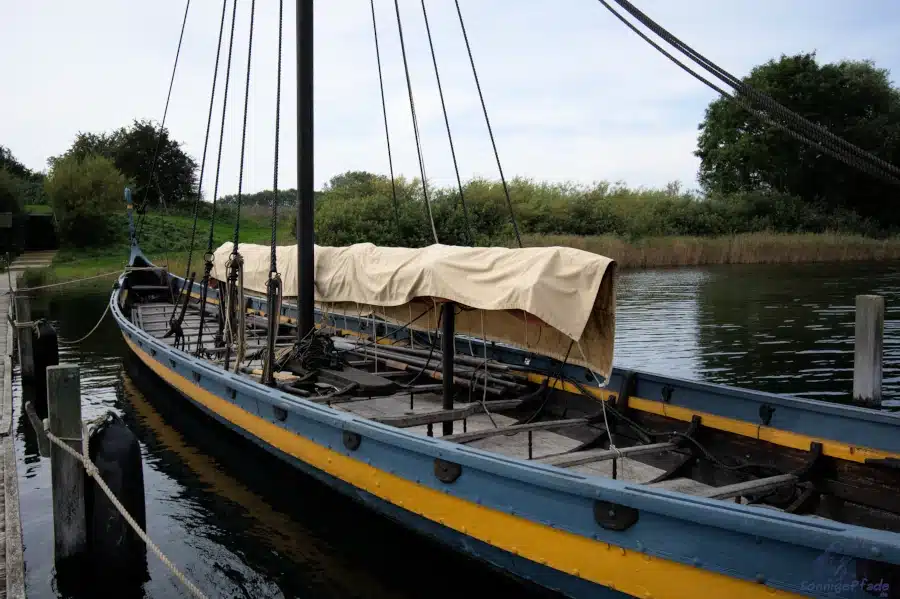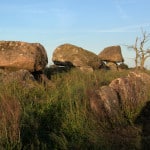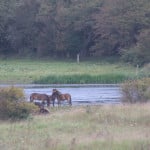
Dark earth in the loamy soil layers indicates a find. Dozens of rusty bolts and a few rings come to light. „A ship! I think it’s a ship!“ exclaims the pharmacist’s son excitedly. And indeed – the outlines of a ship become clearer and clearer as the excavations continue near Ladby. What emerges from the ground at the excavation site from 1935 is the only known ship burial from the Viking Age in the whole of Denmark to date. Since the turn of the millennium, the Ladby Viking Museum has been built in the vicinity of the Ladby ship in the north-east of the Danish island of Funen.
Experience history at the Ladby Viking Museum
A trip to the year 925
Fog and gloomy clouds drift over the fjord on the eastern shore of the island of Funen. But hundreds of Vikings are not deterred by the weather and make their way to their lord’s court. Restlessness, excitement and often sadness mark their faces. They walk along hunched over, only quiet whispering can be heard under the whispering of the wind. Some use the fjord to reach the court in their longboats.
Her sovereign who was their lord and master has passed away. The grief is mixed with uncertainty. The death of a strong leader, who guaranteed order and dispensed justice, all too often means that rank struggles and conflicts of loyalty break out. Added to this is a new religion that is beginning to supplant the old belief in the Nordic world of gods and tells of a single prophet from the Orient. So what is the truth?
But today it is about the burial of their sovereign. The old Viking was rich and powerful, and his burial place is said to be the same. Her sovereign’s longboat has pulled out of the fjord onto the shore and up the embankment. The ruler is buried in his dragon boat. With him are eleven of his beloved horses and his dogs. After the sovereign is deposited in the bow of the longboat, a burial mound is erected over the boat….
Viking Museum Ladby Ship
The burial mound at Kerteminde Fjord
Around 1935, the experienced amateur archaeologist Poul Helweg Mikkelsen, a pharmacist from Odense, was traveling on the island of Funen in search of traces of Danish antiquity. He finds what he is looking for near the village of Ladby, when a mound on Kerteminde Fjord turns out to be a burial mound from the Viking Age. His son, who accompanies the pharmacist with the same curiosity for historical finds, is the first to think that the finds might be a ship. And indeed – the barely recognizable planks in the ground, the nails and rings and, above all, a well-preserved, heavy metalic anchor leave no doubt about the interpretation of the finds. It is a ship burial from the late Viking Age. The burial mound near Ladby was later dated to 925 AD.

Although the nails, bolts, rings and anchors are in good condition, the wooden hull of the boat has practically „grown together“ with the ground and can no longer be removed as such. Involved archaeologists therefore decided to leave the ship in place immediately after the discovery. The finder, Poul Helweg Mikkelsen, financed a concrete superstructure, which was erected over the Ladby ship as a roof and viewing room. The burial mound was then filled in again.
Horse skeletons and dog bones – finds in the Ladby ship
A total of 11 horse skeletons were found in the nave of the grave, from horses that had been deposited as grave goods. Parts of the bronze bridle were also found in this area, as well as a small axe among the skeletons. There were also dog bones among the horse skeletons, which probably came from the Viking prince’s dogs. Bronze parts of the dog leash harness have been preserved.
Metal parts in the bow area represented the „curls“ of the dragon’s head, while further metal parts in the form of „tail scales“ were found at the stern. The well-preserved anchor with its chain lies at the very bow.

It is interesting to note that the longboat rests keel down on the ground, exactly as it floated in the fjord. It is known from other ship graves, e.g. the Gokstad and Oseberg ships in Norway, that they were placed keel up, i.e. „upside down“, with the body and grave goods underneath. The hull of the ship thus formed a burial chamber. The Ladby ship, on the other hand, lay on the ground „ready for use“ for the journey to the afterlife.
Today you can visit the excavation site of the Ladby ship in the burial mound. A light gate takes you into the mound, where you can see the remains of the ship „bedded in clay“ as they were found during the excavation.
At the end of the last millennium, the excavation site had to be re-preserved, as rising soil moisture and microorganisms were causing it to deteriorate. In the meantime, the hull has been surrounded by a glass „sarcophagus“, which protects the findings of the Ladby ship. The burial chamber is largely darkened, probably also to reduce reflections. The darkness in the burial mound thus creates a very special atmosphere.
Aft ship has been cleared out
It had already been noticed during the excavation that the light wooden covering over the ship, which formed a kind of burial chamber, had been destroyed and largely removed in the stern. In addition, in the stern of the ship, where the sovereign’s body and rich grave goods would have been expected, there were only the remains of destroyed vessels, a few pewter buttons, horse harnesses and other fragments. No weapons were found, apart from a metal shield boss and a bundle of 45 arrowheads outside the ship. The most valuable finds were a silver belt buckle and fragments of a silver, gold-plated plate.
Entertainment was also provided: the remains of a game board for Hnefatafl were found, which is something like a „Viking chess game“.

The traces indicate that the Ladby burial mound was broken into as early as around 930. The reason for this is not clear. Several theories are conceivable. A simple theft of the grave goods, some of which were valuable, is possible, but why was the body also removed from the burial mound? It could be a form of posthumous disempowerment of the sovereign by successors or regional competitors – in other words, a desecration of the grave to destroy the existing myth about the deceased Ladby sovereign.
Another theory involves the temporal context: The Viking Age was coming to an end with the Christianization of Denmark, which was driven forward by King Harald Bluetooth. Not without conflict, of course. Was the sovereign possibly reburied and subsequently given a Christian burial? If so, the echoes of his power would have been partially transferred to the Christian community. Or was the sovereign, precisely because he stood against the spread of Christianity, demystified by the robbery of his mortal remains? Here the story remains largely in the dark.
Ladby – Dragon A replica of the burial ship
North of the Ladby burial mound, the Kerteminde Fjord has cut into the landscape. There, below the embankment, the Ladby Dragon is moored at the jetty.
Between 2011 and 2016, craftsmen came to the fjord and rebuilt the Ladby ship in its original dimensions and according to everything that is known about its construction. Now you can see the Viking ship called Ladby Drachen as a slim, elegant replica. In summer, the boat often sails across the Kerteminde Fjord.

The boat has an overall length of 21.5 meters and a width of 3 meters. Maximum draught is 0.5m. The Ladby ship is not seaworthy, but was rather used for inland traffic on the Kerteminde Fjord and near-shore waters. The hull of the Dragon is a clinker construction, as was usual for Viking ships, made of oak planks, which were fastened to the 17 frames with iron nails. Entire ship weighs 3.126 tons, plus around 800 kg of ballast.
The Ladby Dragon is mainly rowed. For this purpose, 32 oars made of pine wood are used. The 62.3 square meter sail is set on downwind courses on the 11m high pine mast.

In the outdoor area of the Viking Museum Ladby
The Viking Museum in Ladby has now developed into an active Viking center. During the summer weeks, the everyday life of the Vikings is brought to life – craftsmen show their skills, sewing, embroidery and building are carried out as in Viking times, the Ladby ship is sailed and rowed and visitors can take part in everything. There are also special activities for children, especially during the vacations.
In the outdoor area, which still offers plenty of space for the expansion of the museum, there are already several houses that may have been common in the villages of Norman times. There are also workshops and gardens. In the future, a Viking „royal court“ is to be built next to the museum building, as it might have looked at the time of the buried sovereign of Ladby. Mobile market stalls made of canvas extend the possibilities.

Picnic areas are available at all times, so that you can also move your family breakfast to the open-air grounds of the Viking Museum. The open-air area at the Ladby ship is partly wheelchair accessible, i.e. wheelchair access to the burial mound has been provided.
Indoor exhibition in the museum building
The old museum building in the Ladby Viking Museum, where the museum ticket office and store are located, has now been extensively extended. As a result, several exhibition rooms have been created, which significantly enrich the insight into the Viking Age.
Artifacts – finds from the surrounding area
A large part of the exhibition is taken up by artifacts from the Viking Age that were found in the Ladby ship burial mound and in the surrounding area on Kerteminde Fjord. These are mainly metal objects such as weapon remains, jewelry, clothing accessories such as buttons, clasps and brooches or the remains of everyday objects such as cooking and table utensils or tools. These are displayed in protected showcases. Pictures and labels explain the origin, intended use and, if applicable, the place of discovery. The information is usually in three languages – Danish, English and German.

The Ladby carpet
Between 2011 and 2017, a group of 16 women came together to embroider a tapestry depicting the history and mythology of the Ladby ship burial site. The model for this was the „Bayeux Tapestry“ in Normandy, which illustrates the history of the Battle of Hastings in 1066 in the south of England. This battle is considered by historians to mark the end of the Viking Age.
In the images on the Ladby tapestry, designer Gudrun Katrine Heltoft has reflected both the burial of the Viking prince in the ship and the temporal background of the conflicting Norse mythology of the Asa faith with the rise of Christianity. The embroiderers invested more than 5000 working hours over a period of 6 years.

Following the example of the Bayeux Tapestry, plant-dyed wool on linen was used for the embroidery. The embroidery was executed in contour stitch, overcast stitch and with French knots. Professional Dyer Annette Nørgaard Bogulski produced the wool for the embroidery with the seven basic colors of the Bayeux Tapestry, supplemented with around 75 other colors from dye plants in the Ladby area.
The Ladby carpet, which is 6.5 meters long, can now be admired in an exhibition room at the Ladby Viking Museum.
Reproduction of the funeral scene
In the basement of the Ladby Viking Museum, the funeral scene with the Ladby ship has been recreated. The body of the Viking sovereign of Ladby lies on a bedstead in the hull of the ship. At his feet is a Hnefatafl game board as well as chests and barrels for grave goods. The anchor and the bodies of horses and dogs lie in the forecastle. Next to the ship’s hull are five symbolic Viking figures – two children, two women and a man as a „mourning congregation“ in typical garments. The landscape of the Kerteminde Fjord can be seen in the background as a mural painting. The burial in 925 could have looked something like this.

Viking clothing and Viking village
A model depicts the houses and huts of a Viking village – just as the royal court at Kerteminde Fjord might have been structured. A comparable view of the royal court of Ladby is gradually being created in the museum’s outdoor area.

Viking clothing is also on display in the exhibition. Based on finds at various locations in Denmark, fabrics were woven that resemble those from the Viking Age in terms of material, structure and coloring. Standing figures are dressed accordingly, just as they were for the different classes in Viking society. Even an individual Viking fashion show is possible: in one room of the museum there are various models of clothing for women, men and children that can be tried on. Nothing stands in the way of a „Viking family photo shoot„!
Travel tips for the Viking Museum Ladby
How to get there
Kerteminde, the town to which Ladby belongs, is located in the north-east of the Danish island of Funen on the Great Belt.
The Viking Museum Ladby is located directly on the Kerteminde Fjord. The small village of Ladby is about 4 km southwest of Kerteminde and to get to the museum you have to drive about 1 km out of the village.

It is easy and very pleasant to get to your destination on the island of Funen by bike along small roads in the warmer months. For example, the Viking Museum Ladby can be part of a cycle tour through East Funen, where Svendborg, the Renaissance castle of Egeskov, the dolmens of Lindeskov and the natural landscapes north of Kerteminde can also be stops. For some time now, I have preferred to plan my cycle routes with openrouteservice.org, where I can create a gpx track of the completed route for my Garmin outdoor navigation system.
Kerteminde can be reached by car from Fynske Motorvej, the E20 highway. Take the Langeskov or Nyborg V exit, depending on where you are coming from. Keep north and in Ullerslev turn north onto regional road 315 towards Kerteminde. Before you reach Kerteminde, turn west in Revninge or Skraekkenborg and you will reach Ladby. The road to the Ladby Viking Museum is signposted from there.
Ladby ship Viking Museum – Opening hours, prices and address
The Ladby Viking Museum is open from May to September. The opening hours are Tuesday to Sunday from 10:00 to 16:00. In the summer months from June to August, the museum is open all week (including Mondays) from 10:00 to 17:00.
Admission is free from 0 to 18 years. For adults, admission costs DKK 100.
Address: Vikingemuseet Ladbyskibet
Vikingevej 123, Ladby, 5300 Kerteminde
E-mail: vikingemuseet@ostfynsmuseer.dk
Internet: Vikingemuseet Ladby dk
Visiting Ladby Viking museum with children
You should visit the Ladby Viking Museum also with children, and not just because admission is free for children. It’s simply worth it! You can immerse yourself with your family in the time of the Vikings 1000 years ago. This is a vivid history lesson, especially in the summer months. This is when the „Ladby Royal Court“ becomes a real Viking camp. Both crafts and household chores are demonstrated or tried out with you, just like in Viking times.
The Ladby dragon, the longship can sail on the Kertemindefjord and there is a lot to see. Even when the weather is not so nice, the indoor exhibition in the museum building is interesting, even for children. They can even slip into real Viking outfits for a souvenir photo. Older children can perhaps also try their hand at Hnefatafl, the Viking board game. A large game board can be found in the basement of the exhibition.

And, the grounds leave plenty of room for movement. The visit to the burial mound in particular is impressive given the dark space underground, even if children might prefer to see more details. But sometimes the hints and forebodings in mystical surroundings are more memorable than flat images….
If you are planning a longer visit to the Ladby Viking Museum, you should pack your own food. There are no facilities for this on site. Picnic tables and benches are available in several outdoor areas. The nearest restaurants are in Kerteminde.
Weather at Kerteminde Fjord
A visit to the Viking Museum in Ladby is of course best in dry weather. Then you can spend more time in the outdoor area. For better planning, the adjacent overview shows you the weather forecast at Kerteminde Fjord for today and the next three days.
More tips for your Danish islands cycle tour?
Visit the Lindeskov megalith tombs in the East of Funen island!





